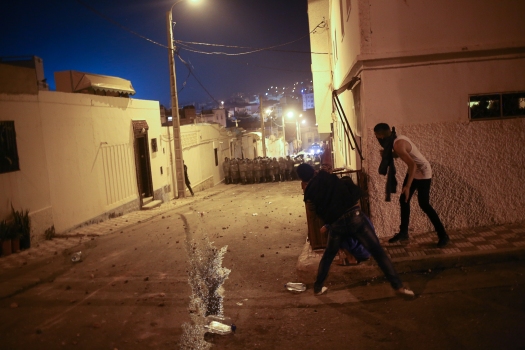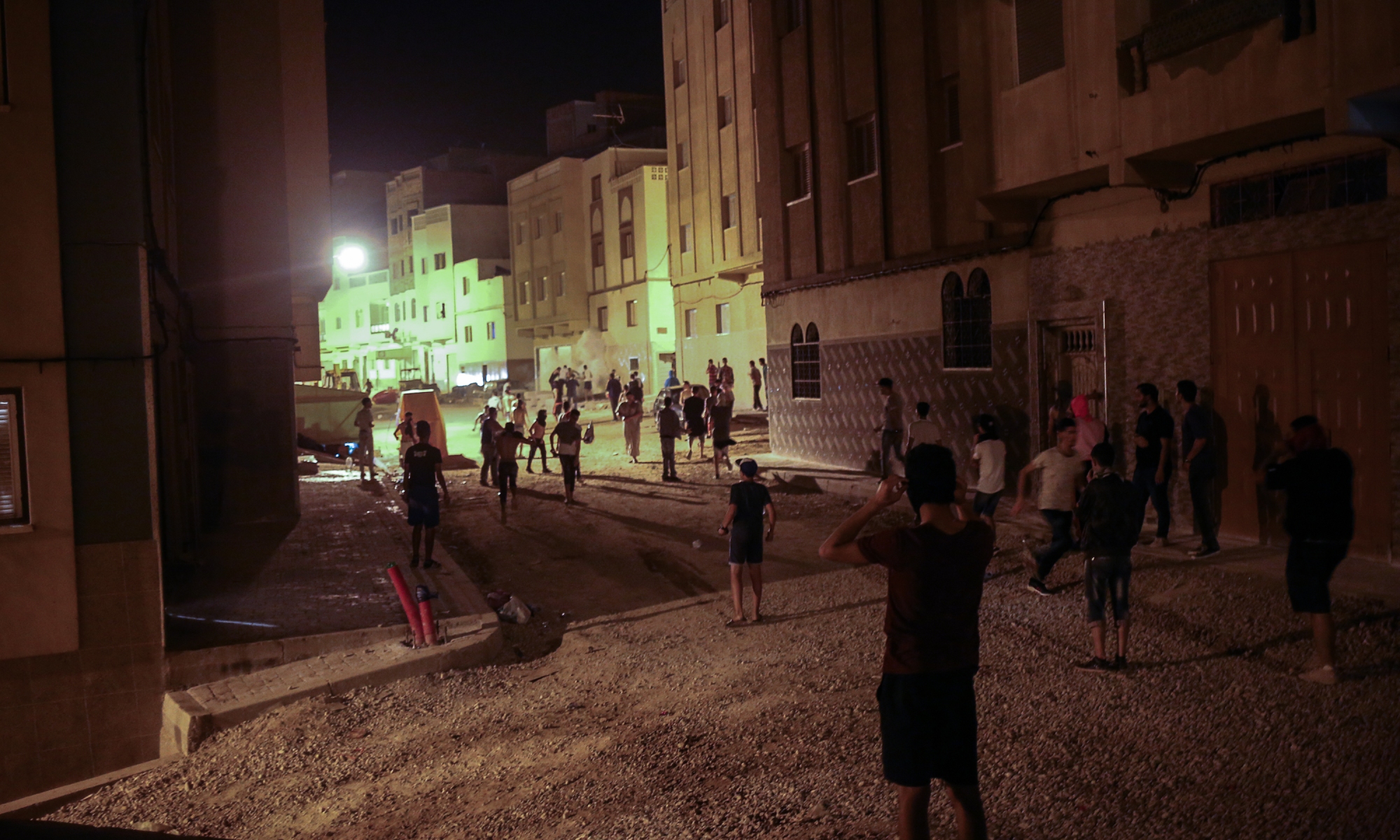With 32 activists given ‘shameful’ sentences in al-Hoceima last Tuesday, with only more arrested and more tried since, the nightly riots in al-Hoceima – from 10pm to 12pm, after the final adhan, before the police’s curfew – have gotten more intense, with rock-marked riots vans moving together, fast, through the working-class districts of Sidi Abed and Marmoucha.
Visiting the country on Wednesday, Emmanuel Macron assured the Moroccan people that King Moahmed VI appreciates their constitutional right to protest; but, anger at the prison sentences – and that the King appears to speaks to le president first, before the Rif – has brought protestors in al-Hoceima saying, for the first time, ‘silmiyya, c’est fini’ – ‘peacefulness, it’s over’.
I was somewhere near al-Hoceima, the urban hub of the northeastly Rif region, when I spoke with a left-wing activist from the region about The Popular Movement and the King, the Rif and Morocco, and the possible trajectories of political change here. This is part one of two, with the second out next Sunday.
—
Could you explain how The Popular Movement developed?
The Movement began in October last year, with the killing of Mohasin Fikri. He was a fish merchant, with a relatively large amount of off-season fish.
There are two versions of his killing. The first and more-repeated by the press is that the police asked him for a bribe that he refused, and so they put his fish in a rubbish truck. He tried to get in, and one police officer said ‘tahan mu’ (‘crush his mother’).
The other version, which I think is more credible, is that Fikri went into the refuse truck before the fish, as if to say ‘I need this to live, this is my livelihood, you must go through me’. He was resisting.
‘Tahan mu’ enraged people; it’s like people of authority don’t care at all about citizens. They can crush us at will, kill anyone they like. In addition, it was said in a foreign language, in Arabic; people are particularly sensitive to abuses of power by Moroccan officials.
Mohasin Fikri was called on Friday evening, and there were protests in al-Hoceima immediately after. The funeral procession was on the Saturday. On the Sunday, there were protests in Rabat, Casablanca, Marrakech. It seemed to me – maybe I’m mistaken – that protests stopped soon after though.
There was solidarity from other parts of the Morocco. But soon, except in the Rif, all cities ceased their demonstrations. And there were small protests in the Rif but, after them, it was more of a mobilisation. Nasser al-Zafzafi and his friends, other activists, went across the small towns, talking to people, discussing their problems. For the first time, people found someone they can talk to; someone they feel with whom there is two-way commuinication, someone that can understand them. That it was the al-Makhzan fears, and what it can’t do; it can’t attract people to it. Al-Zafzafi did. You know, every town to which al-Zafzafi went is now staging protests every day, asking for his release.
Demands were developed: how?
There was a long debate in towns, on the internet, so everyone could contribute, so they can discuss in their own town a solution to their own problem. There were ‘brainstorming’ sessions. There was a release of preliminary demands in Novemebr, and anyone who had any additions, or modifications, were able to contact organizers.
The list was to be adopted at a public demonstration on February 5th, but it was very heavily repressed. The demands were released a month later, on March 5th. February 5th was a symbolic date, the date that ‘abd al-Karim al-Kitabi passed away in Cairo. There was a lot of symbolism. Everything the state does, they respond with something from the past, from history.
Ministers were ignored when they visited al-Hoceima on May 22nd. It was only a week after they accused The Movement of seperatism – a statement produced by the al-Makhzan. When they issued the 14th of May statement, actvists responded with a question from al-Kitabi who, in response to the mass executions and arrests in 1958, asked ‘are you a government or a mafia?’
In October the protests were against al-Hugra (‘official abuse’). But, after a period of discussion, protest, and repression, it’s no longer just ‘official abuse’ people are against; people are demanding what we tend to call ‘social services’ in the UK; health care, schooling, and so on.
Yes. People are keeping away from political demands, they are asking for hospitals and schools. Some of those demands, the government say, are already being delivered by a project called ‘Hoceima, Lighthouse of the Mediterranean’. That projectwas started in 2015, but we haven’t seen anything from it.
But the Rifian separatists’ claim – they call themselves republicans, and I share some of their ideas – is that there is something rotten in the Moroccan state that you cannot change with a budget; it has to change politically. The Movement is not making political demands. I hope it will evolve in time to demand something like home-rule, or federalism; money can’t change the Moroccan state.
Al-Hirak hasn’t made explicitly constitutional or territorial demands. They are demanding very serious changes to how people live, though. What struck me about their social claims was that they both spoke to the Rif, but also to people across the whole country. They were both specific and general. This seemed sound, strategically.
They are, as you say, thinking strategically. They say: ‘what we are asking for are basics, basics for any democratic country’. If they started with political demands like home-rule, or federalism, or some form power-sharing, that would have frightened the government. The crackdown would have begun immediately, the same day Mohasin was killed. It was a strategy to make time for mobilisations.
There are places in Morocco worse than the Rif; some places are living as if in the Stone Age, with no aspect of modern life. They need those services even more than us. This is what al-Zafzafi’s idea was.
I think the most important step that The Movement has taken is to allow every political group and union onto demonstrations, whilst preventing them from influencing the leadership. At demos, you see Islamists, far-left, from every political group, but they are there as individuals.
How does The Movement formally relate to other political groups? I heard there no are formal relations with other groups, not even democratic forces?
After Mohasin’s death, al-Zafzafi said we should not work with other parties. He called them ‘dakakin siasia’ (‘political shops’); he wanted this movement to be completely independent from anything to do with the state.
You see, this obsession with organisational independence is because the Rif was cheated, was deceived, many times through history. People have pretended to defend the interests’ of the population, but they were just seeking their own interests.
After the 2004 earthquake, local notables formed a committee to oversee reconstruction. The committee presented itself as an independent body, motivated only by the common good. They had the approval of the government. But the reconstruction process was plagued with irregularities and embezzlements. Later, an association was formed to hold the committee accountable. The association was presided over by a radical, a communist, who had the support of the population, but he eventually sold out. These and other similar disappointments made the Rifian population skeptical of individuals or groups pretending to serve the common good.
The Movement has called for similar grassroots organisations to appear in every part of the country. They can formulate their own demands, depending on what they need. For example, in the Rif, we need cancer hospitals, and also a seismology institute, because this area is prone to earthquakes. It was that idea; that Morocco would see many al-Hirak-like movements in all of Moroco, with localised demands.
Women and demands for women’s rights have been vital to the growth of al-Hirak. Could you explain a little?
Rifian society is a little conservative: women don’t usually take part in politics. It has been a message, a very strong message, that women have demanded the same rights as men. Some of the strongest and most influential in the leaderdership are women. Nawal Ben Aissa, for example, who before the movement was helping women with cancer, especially women from rural areas. She was an activist, even before the movement.
I didn’t expect women to participate in this strong way. It was really surprising. I mean, women do take part in smaller aspects of politics, but not like this, in such a strong way. It’s like there’s a change in society.
(At this point, I show my friend a photo of a group of women imploring young men to stop throwing stones at police, taken that Wednesday.)
Yes, of course. They know it’s them that police will hurt first.
Al-Hirak’s leadership layer are all working-class. Al-Zafzafi was a taxi driver, and so on. Al-Sh’abab (‘The Youth’), those protestsing every night, are poor working-class, almost all young, underemployed or unemployed men. Al-Makhzani patrimonialism inevitably excludes or hampers some capital. Are there any Rifian capitalist who support the movement?
You’re wrong. There is no substantial part of the capialist class that isn’t loyal to the regime. During the 20th February Movement, one multi-millionaire, Karim Tazi, was helping the movement, with money for printing and so on. So they came to him with a fiscal audit, and he was found to owe millions to the state. Everyone with any business in Morocco is breaking some law; if you’re with The Movement, the state will come for you.

—
In Part Two, we discuss the relationship between ‘Islamist’ and the Amazigh rights movements in Morocco, ‘Moroccan exceptionalism’, and the political uses of democracy.


One Reply to “”